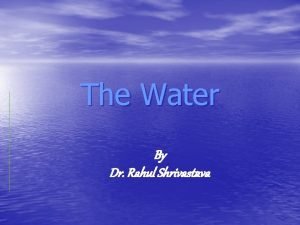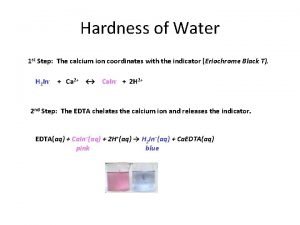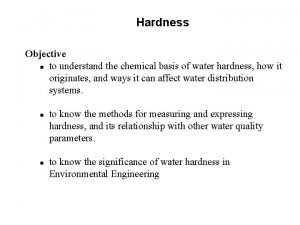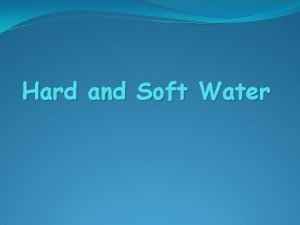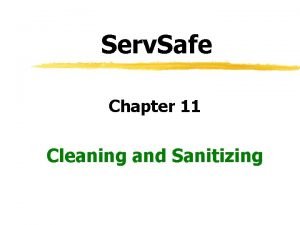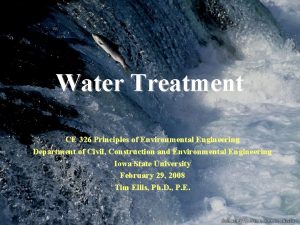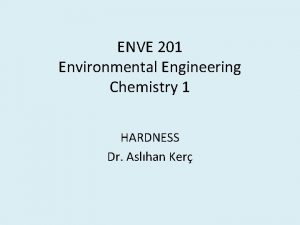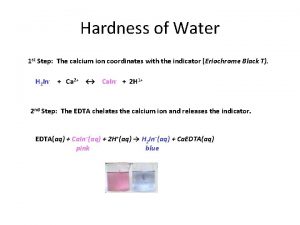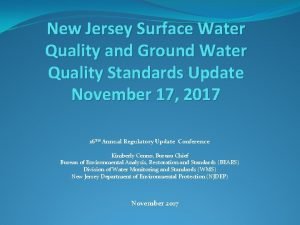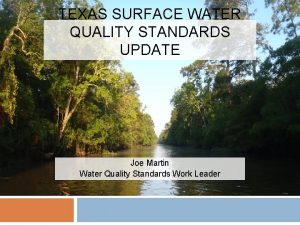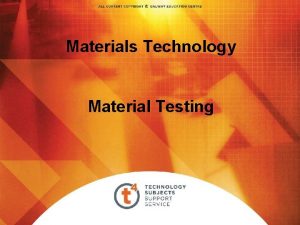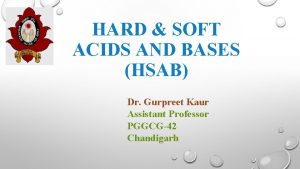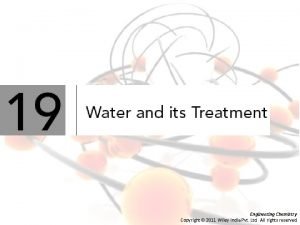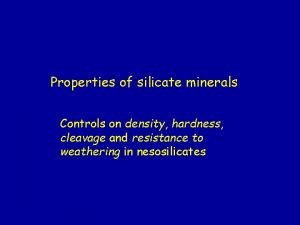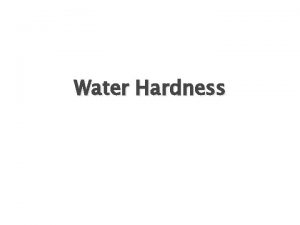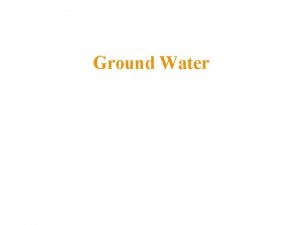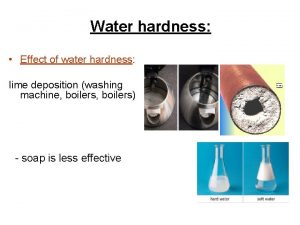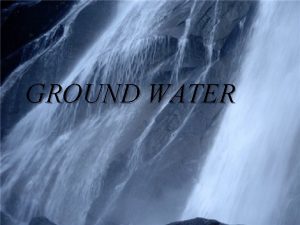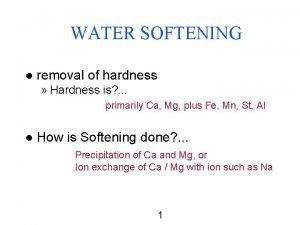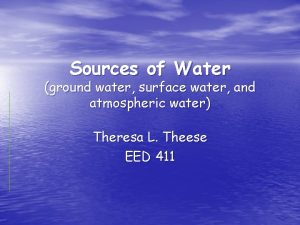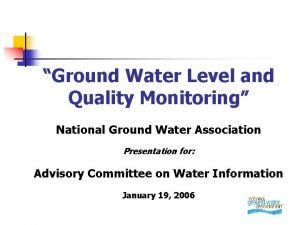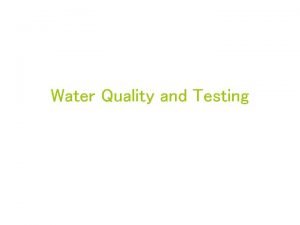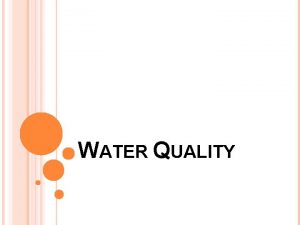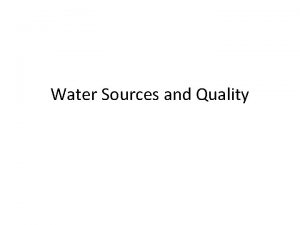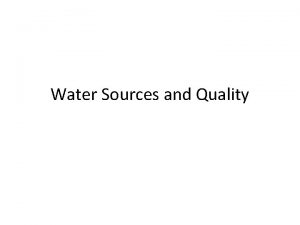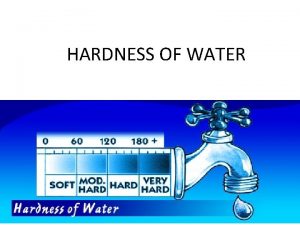Water Sources Quality Standards Terms Ground water Hardness

























- Slides: 25

Water Sources & Quality Standards

Terms Ø Ground water Ø Hardness Ø Surface water Ø Turbidity Ø Water quality

Sources of Water Ø Two main sources of water are surface water and ground water.

Surface Water Ø Can be found on the surface of the earth in lakes, streams, rivers, and oceans. Ø Can be either freshwater or saltwater. Ø Main source = precipitation. Ø Good for human consumption and agricultural use. Ø Surface water should be treated before use.

Groundwater Ø Water from within the earth. Ø May be located a few feet or thousands of feet within the earth. Provides much of the freshwater we use. Ø Can usually be used with little treatment. Ø

Water Quality Factors Ø Odor and Taste Ø Color Ø p. H Ø Hardness Ø Turbidity Ø Heavy Metals Ø Chemical Residues Ø Coliform Bacteria

Odor and Taste Ø Bad odor and taste in water may result from… Ø pollution, sulfur, or microorganisms

Color Ø For most people, clean, clear water is their first choice Ø However, colored water may be safe to drink Ø often the result of mineral presence. Ø Minerals that may change the color of water include: Ø iron, magnesium, and calcium Ø Other Ø factors…. sediment, organic matter, and plankton.

p. H Ø The p. H of water is commonly between 5. 5 to 8. 6

Hardness Ø The presence of calcium and magnesium ions in water Ø The greater the presence of these ions, the harder the water Ø Hard water leaves residue in hot water pipes and water heaters.

Turbidity Ø The solid material suspended in water Ø These materials may be soil particles or microscopic organisms. Ø To remove turbidity, the water has to be filtered and the particles allowed to settle

Heavy Metals Ø Including mercury and lead, may be hazardous to the water supply Ø Lead was once commonly used to seal joints, now that lead may leak into the water supply within the pipes. Ø These pipes should be replaced

Chemical Residues Ø Chemical residues from various chemicals including pesticides can be dangerous to human health. Ø However, the extent of these dangers is still unknown

Coliform Bacteria Ø An indication of fecal contamination in the water supply. Ø The contamination may result from human or animal waste getting into the water. Ø Water contaminated with coliform bacteria is not fit for consumption. Ø Coliform bacteria can be destroyed by boiling the water.

What to Test for and When? Ø Testing your household water supply is important to the health of everyone within the house. Ø Invisible contaminants in the water may be hazardous. Ø Visible contaminants can be harmful to both people and household items. Ø Other pollutants may not be harmful but may leave the water unfit to drink or cook with.

Testing Household Water Supplies Ø No matter the problem, water testing will help determine how to solve it. Ø Regular water tests that should be done on a yearly basis include coliform, nitrate, and p. H. Ø Regular water tests that should be done every three years include tests for sulfate, chloride, iron, manganese, and lead.

Testing Household Water Supplies Ø In special situations, water should be tested more frequently and more thoroughly. Ø Examples of such situations include the location of the water source to agricultural use, drilling, and landfills or dumps. Ø Each of these may be responsible for contamination to local water supplies.

Specific Areas of Testing Ø Bacteriological Ø Mineral Ø Chemical

Bacteriological testing Ø Determines the presence of bacteria that may cause disease. Ø The most common bacteria to test for is coliform.

Mineral Testing Ø Determines the level of mineral impurities in the water. Ø Large amounts of minerals can be hazardous and may reduce the usefulness of the water. Ø Common minerals to be tested for include calcium, iron, copper, zinc, manganese, and magnesium.

Chemical Testing Ø An expensive process, therefore it is usually only done when contamination is suspected. Ø Common chemical pollutants include petroleum products and agricultural and industrial chemicals.

Identifying & Reducing Water Pollution

What causes water pollution? n Can be from a number of sources Tanker full of chemicals spilling in ocean u OR…. u Invisible like acid rain u

Point source vs. Non-point source n Point source pollution –easily identifiable & can be easily stopped u Ex: wastewater from factories n Non-point source pollution – pollution that is not easily identifiable & may be from a number of sources. u Ex: runoff of water carrying pesticides from a farm field

What sources cause pollution? n Sediments – loose particles like sand, silt & clay n Pathogens – living & non-living organisms that cause disease n Thermal pollution n Wastes
 Importance of water resources
Importance of water resources Discuss how permanent hardness of water can be removed
Discuss how permanent hardness of water can be removed How to calculate total hardness
How to calculate total hardness How to calculate total hardness
How to calculate total hardness Knockhardy gcse
Knockhardy gcse Carbonic acid and calcium carbonate equation
Carbonic acid and calcium carbonate equation What information should a master cleaning schedule contain
What information should a master cleaning schedule contain Removal of water hardness
Removal of water hardness Pseudo hardness
Pseudo hardness Units of hardness of water
Units of hardness of water Njdep gwqs
Njdep gwqs Texas surface water quality standards
Texas surface water quality standards Print and web sources
Print and web sources Water and water and water water
Water and water and water water Polynomial classification
Polynomial classification Finding like terms
Finding like terms Minecraft block hardness
Minecraft block hardness Silicate minerals in mohs scale
Silicate minerals in mohs scale Workshop test for hardness
Workshop test for hardness Hardness test is the ability of a material to resist
Hardness test is the ability of a material to resist Hsab principle
Hsab principle Mica mineral hardness
Mica mineral hardness Equivalent weight of caco3
Equivalent weight of caco3 Free-hand notching
Free-hand notching Erection hardness scale
Erection hardness scale Silicate hardness
Silicate hardness

